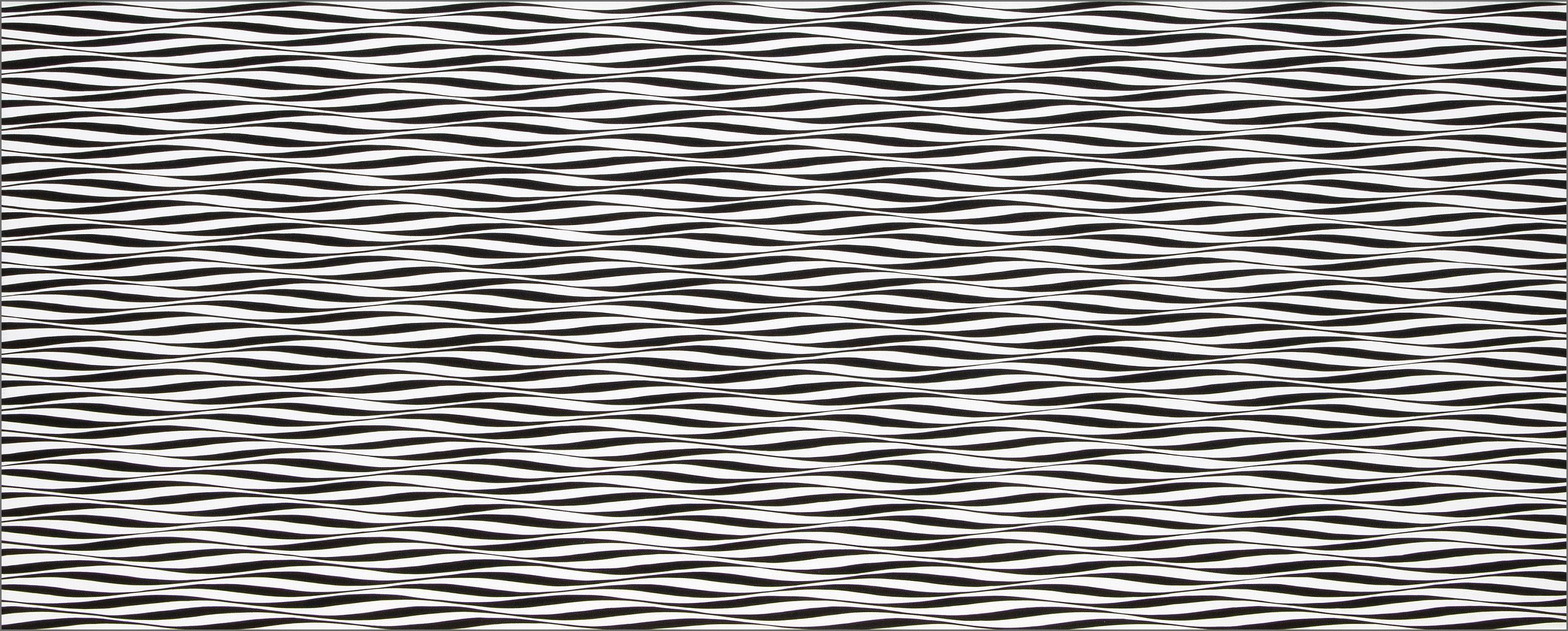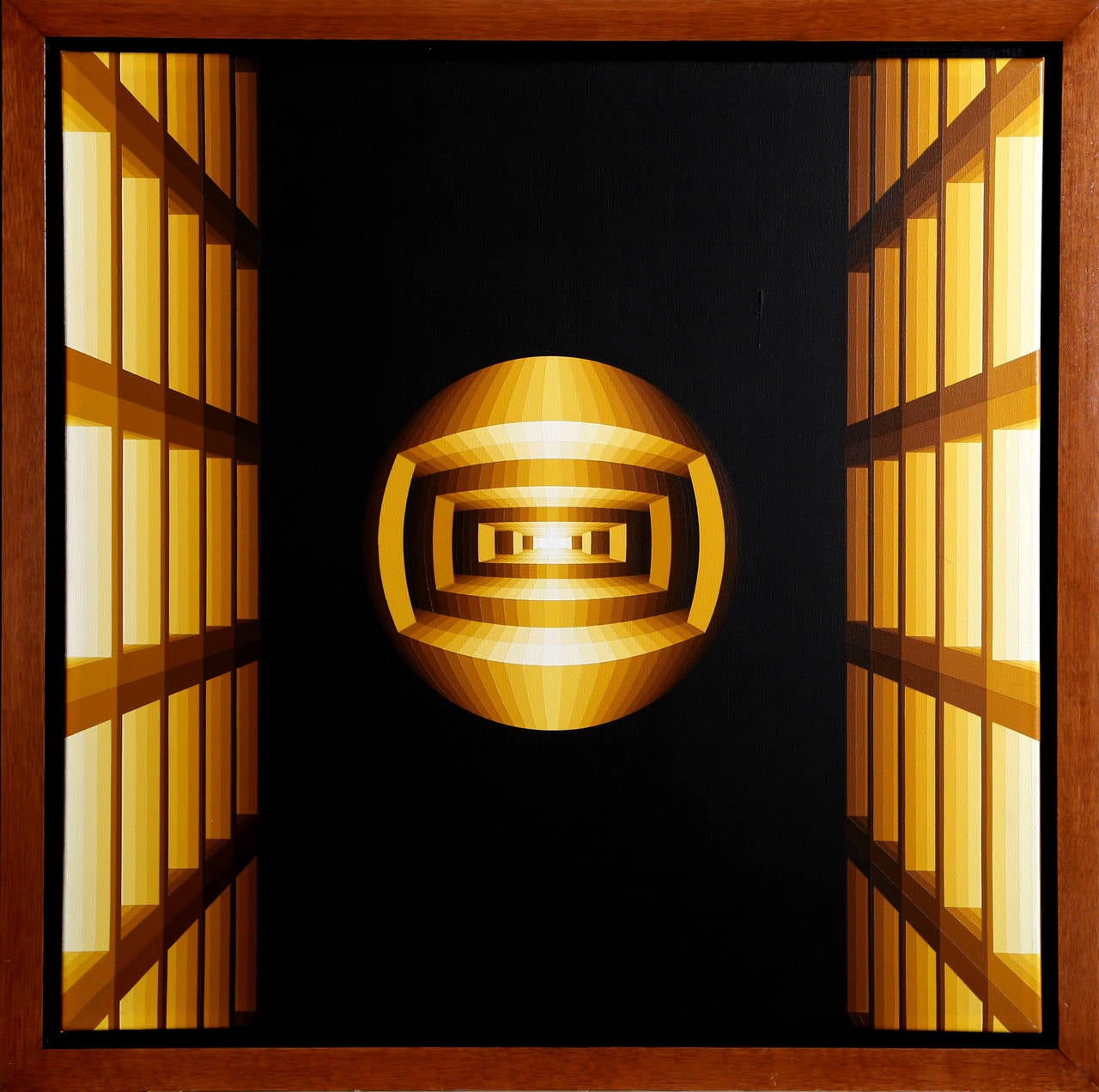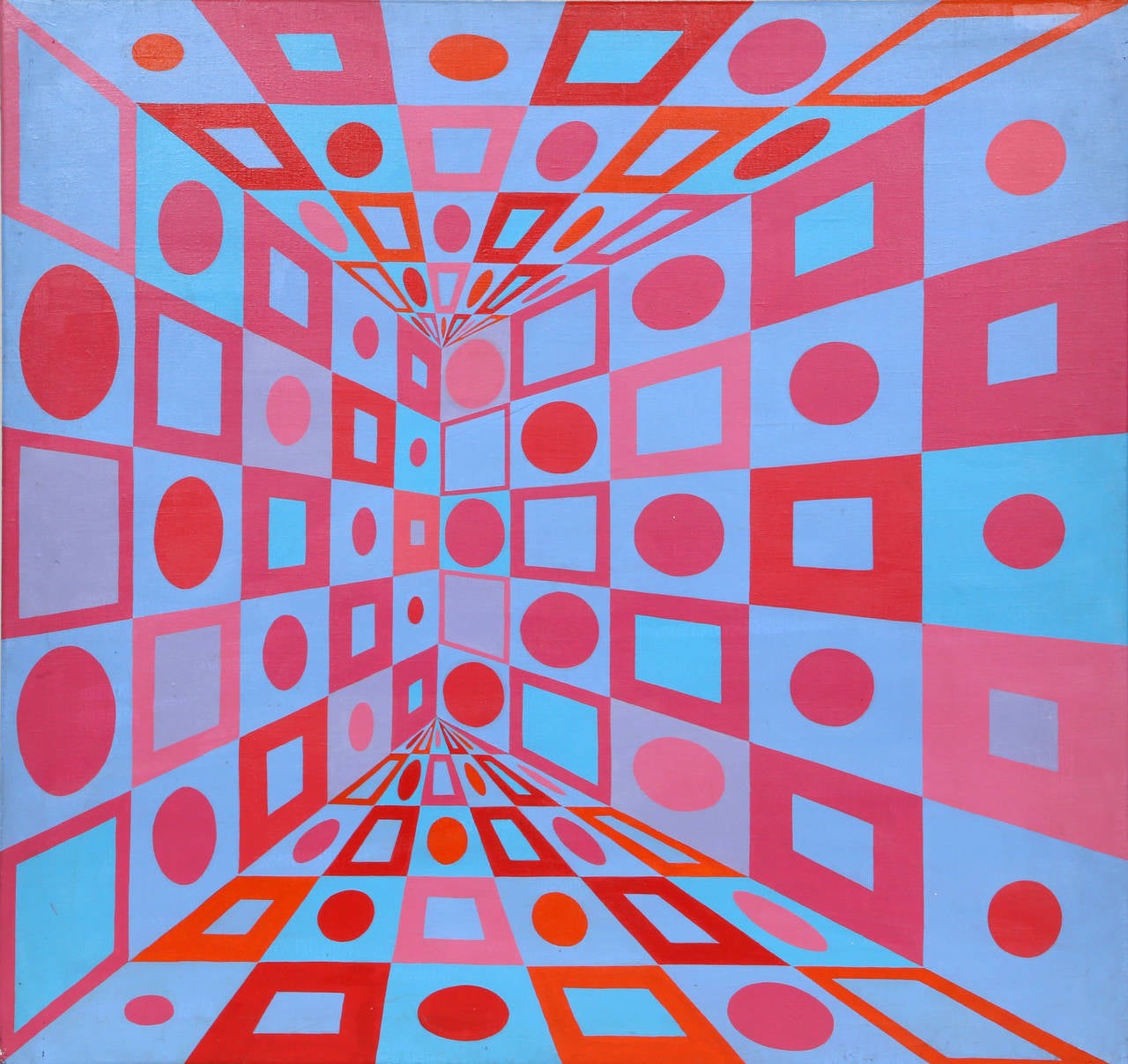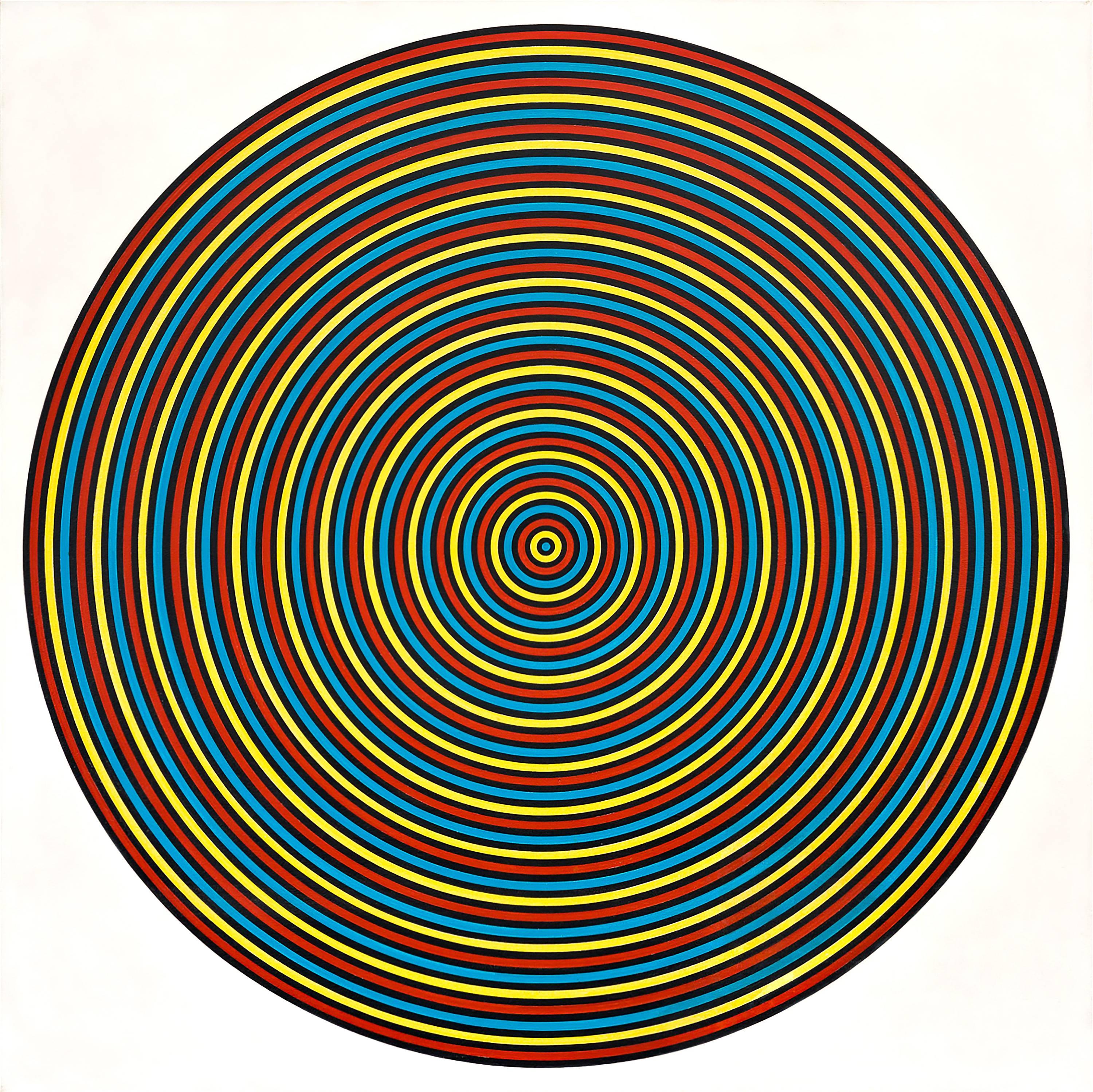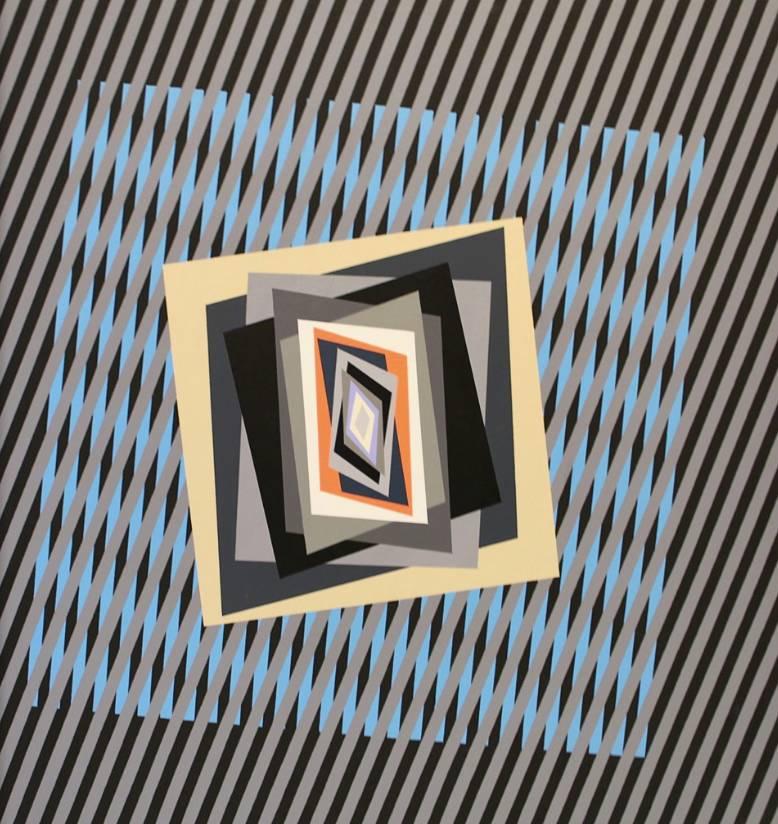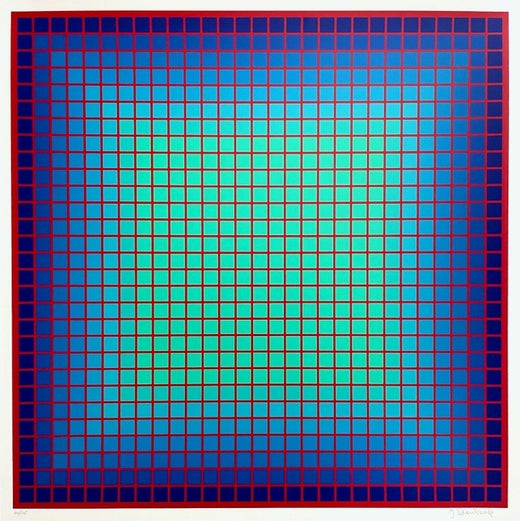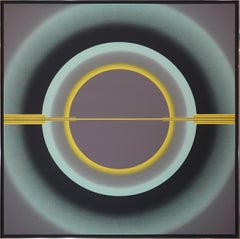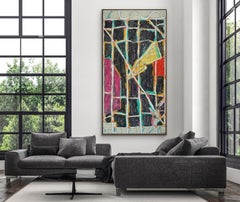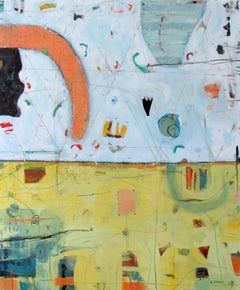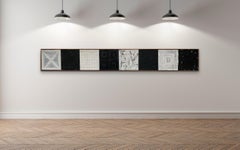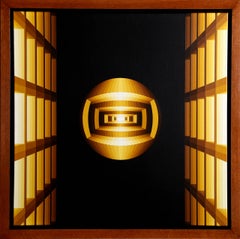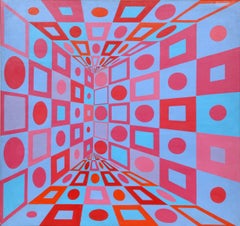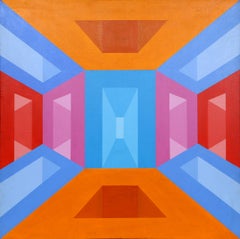Items Similar to JULIAN STANCZAK Sequential Chroma #4 1980 OP ART Painting Red Blue Violet Purple
Video Loading
Want more images or videos?
Request additional images or videos from the seller
1 of 16
Julian StanczakJULIAN STANCZAK Sequential Chroma #4 1980 OP ART Painting Red Blue Violet Purple1980
1980
About the Item
Signed, dated and titled on verso
Original frame by the artist
Provenance: Private Collection, Cleveland, Ohio; Acquired directly from the artist in 1980.
Julian Stanczak's Sequential Chroma #4 (1980) is a striking example of Op Art—a movement known for its optical illusions and visual dynamism. Measuring 44 x 38 inches and rendered in acrylic on canvas, the work exemplifies Stanczak’s mastery of color relationships and geometric precision. The composition is meticulously constructed with a grid of squares that radiate an intricate interplay of hues, creating a mesmerizing visual effect.
The painting’s title, Sequential Chroma #4, highlights Stanczak’s deliberate approach to exploring the sequential interaction of colors. The chromatic shifts within the grid seem to pulse, oscillate, and vibrate as the viewer’s gaze moves across the surface. This dynamic is not merely visual but psychological, as Stanczak’s careful modulation of tones creates a sense of depth and movement that defies the painting’s two-dimensional plane. The grid structure offers a sense of order, yet the gradation of color imbues the work with vitality and rhythmic energy.
What makes this painting particularly compelling is its ability to engage viewers in an active experience. The eye is drawn into the grid’s center, where colors appear to intensify, then pulled outward as the edges subtly fade into cooler, darker tones. This shifting focus mirrors Stanczak’s lifelong interest in perception and the ways in which color and form interact to shape human experience.
Stanczak, a Polish-born artist who survived significant hardships during World War II, brought a deeply personal understanding of resilience and transformation to his work. His fascination with color and its emotive potential can be seen as a metaphor for renewal and hope—a theme that resonates within Sequential Chroma #4. The painting invites contemplation, not just of its formal elements, but of the profound effects that color and pattern can have on the mind and spirit.
Ultimately, Sequential Chroma #4 is a testament to Julian Stanczak’s innovative contributions to Op Art and his unique ability to craft compositions that are both technically precise and deeply moving. It is a work that bridges the gap between science and art, logic and emotion, offering a dynamic and transformative visual experience.
ARTIST BIO
Julian Stanczak was born in Borownica, Poland in 1928. At the beginning of World War II, Stanczak was forced into a Siberian labor camp, where he permanently lost the use of his right arm. He had been right-handed. In 1942, aged thirteen, Stanczak escaped from Siberia to join the Anders' Army in Persia. After deserting from the army, he spent his teenage years in a hut in a Polish refugee camp in Uganda. In Africa, Stanczak learned to write and paint left-handed. He then spent some years in London, before moving to the United States in 1950. He settled in Cleveland, Ohio. He became a United States citizen in 1957, taught at the Art Academy of Cincinnati for 7 years.
In 2007, Stanczak was interviewed by Brian Sherwin for Myartspace. During the interview, Stanczak recalled his experiences with war and the loss of his right arm and how both influenced his art. Stanczak explained, "The transition from using my left hand as my right, main hand, was very difficult. My youthful experiences with the atrocities of the Second World War are with me,- but I wanted to forget them and live a "normal" life and adapt into society more fully. In the search for Art, you have to separate what is emotional and what is logical. I did not want to be bombarded daily by the past,- I looked for anonymity of actions through non-referential, abstract art." Wikipedia
- Creator:Julian Stanczak (1928, American)
- Creation Year:1980
- Dimensions:Height: 44 in (111.76 cm)Width: 38 in (96.52 cm)
- Medium:
- Movement & Style:
- Period:
- Condition:
- Gallery Location:Rancho Santa Fe, CA
- Reference Number:1stDibs: LU516312557972
Julian Stanczak
Julian Stanczak was born in Borownica, Poland in 1928. At the beginning of World War II, Stanczak was forced into a Siberian labor camp, where he permanently lost the use of his right arm. He had been right-handed. In 1942, aged thirteen, Stanczak escaped from Siberia to join the Anders' Army in Persia. After deserting from the army, he spent his teenage years in a hut in a Polish refugee camp in Uganda. In Africa, Stanczak learned to write and paint left-handed. He then spent some years in London, before moving to the United States in 1950. He settled in Cleveland, Ohio. He became a United States citizen in 1957, taught at the Cincinnati Academy of Art for 7 years. The Op Art movement was named after his first major show, Julian Stanczak: Optical Paintings, held at the Martha Jackson Gallery in New York in 1964. His work was included in the Museum of Modern Art's 1965 exhibition The Responsive Eye. In 1966 he was named a "New Talent" by Art in America magazine. In the early 1960s he began to make the surface plane of the painting vibrate through his use of wavy lines and contrasting colors in works such as Provocative Current (1965). These paintings gave way to more complex compositions constructed with geometric rigidity yet softened with varying degrees of color transparency such as Netted Green (1972). In addition to being an artist, Stanczak was also a teacher, having worked at the Art Academy of Cincinnati from 1957–64 and as Professor of Painting, at the Cleveland Institute of Art, 1964-1995. He was named "Outstanding American Educator" by the Educators of America in 1970. (Wikipedia)
About the Seller
5.0
Vetted Professional Seller
Every seller passes strict standards for authenticity and reliability
Established in 1984
1stDibs seller since 2016
88 sales on 1stDibs
Typical response time: 12 hours
- ShippingRetrieving quote...Shipping from: Cleveland, OH
- Return Policy
Authenticity Guarantee
In the unlikely event there’s an issue with an item’s authenticity, contact us within 1 year for a full refund. DetailsMoney-Back Guarantee
If your item is not as described, is damaged in transit, or does not arrive, contact us within 7 days for a full refund. Details24-Hour Cancellation
You have a 24-hour grace period in which to reconsider your purchase, with no questions asked.Vetted Professional Sellers
Our world-class sellers must adhere to strict standards for service and quality, maintaining the integrity of our listings.Price-Match Guarantee
If you find that a seller listed the same item for a lower price elsewhere, we’ll match it.Trusted Global Delivery
Our best-in-class carrier network provides specialized shipping options worldwide, including custom delivery.More From This Seller
View AllOP ART “Emanations: O_EM 18 24” Blue Black CONTEMPORARY POLISH FEMALE ARTIST
Located in Rancho Santa Fe, CA
“Emanations: O_EM 18 24” is a stunning, contemporary, Op Art painting created by Polish, female artist, Pi Square Milena Kornacka.
Signed, titled and dated v...
Category
2010s Op Art Abstract Paintings
Materials
Canvas, Acrylic
CRAIG KAUFFMAN “Phantom” 1982 Painting Red Yellow Black Green Blue 10 Feet Tall
By Craig Kauffman
Located in Rancho Santa Fe, CA
A wonderful, museum caliber painting by Craig Kauffman.
Initialed "CK" and dated "82" in the lower right corner.
PROVENANCE: Asher Faure Gallery
Luther Vandross
Luther Vandross Estate
Private Collection, New York
Private Collection, San Diego, CA
EXHIBITED: Asher Faure Gallery, Los Angeles, California,
CRAIG KAUFFMAN: NEW PAINTINGS
April 23 through May 21,1983
CATALOGUE: Craig Kauffman Estate Archive Number CR No: P.1982.2
The following is from The New York Times, May 15, 2010, By Douglas Martin
Craig Kauffman, who in the 1960s helped put Los Angeles on the art map with audacious experiments in molding industrial plastic to create ethereal wall-mounted sculptures — some resembling giant pieces of jelly candy — died Sunday in Angeles City in the Philippines. He was 78. The cause was complications of pneumonia following a recent stroke, said Frank Lloyd, his friend and dealer.
Mr. Kauffman was eminent in an eclectic group of artists who reveled in the light, space and energy of postwar Southern California to forge new Minimalist, often glossy artistic approaches. Richard Armstrong, director of the Guggenheim Museum said that these Californians, sometimes called the Cool School — along with Chicago Imagists and Washington, D.C., painters called the Color School — were counterpoints to the Abstract Expressionists who ruled New York.
"California was never ashamed of being a new society," Mr. Armstrong said in an interview on Thursday, "it all fit together nicely."
Los Angeles was then ascending to the status of a metropolis, with a growing number of major-league sports teams, fresh industries and a surging population. There were new quarters for public galleries and the burgeoning of commercial ones.
At the center of the action was the Ferus Gallery, which staged the first solo exhibition of Andy's Warhol's pop art and the first American retrospective of Marcel Duchamp. Mr. Kauffman was a featured artist at the gallery's inaugural exhibition in 1957, "Objects on the New Landscape Demanding of the Eye."
Peter Plagens, in his book Sunshine Muse: Art on the West Coast, 1945-1970, (1974, 1999), wrote, "'Culture' meant 'art' and 'art' implied 'new,' and 'new,' as everybody was informed, meant California — particularly Los Angeles."
The artists who seized this historic opportunity included Billy Al Bengston, Ken Price and Robert Irwin, among others. In an interview on Wednesday, Arne Glimcher, founder and chairman of Pace Gallery, which had Mr. Kauffman's first New York show in 1967, called the California scene in the late '50s and early '60s "a pressure cooker of ideas." Referring to artistic styles, he said, "It was California perfection against New York messiness."
Mr. Kauffman's early paintings were critical in defining this new style. Mr. Plagens called them "the first evidence of a Los Angeles sensibility."
Mr. Kauffman's later work blazed splashier trails, as he experimented with the effects of light on works that were painterly yet three-dimensional. "The true power of what he did was his incorporation and then redirection of light inside sculpture," said Mr. Armstrong, who was the curator of a show of Mr. Kauffman's work at the Whitney Museum of American Art in 1987.
"Many of them glowed," he said. "Others were translucent. Even the supposedly opaque had a noteworthy shimmering quality to them."
What Mr. Kauffman made reflected a wide range of inspirations. In a 2008 video interview in conjunction with a show at the Armory Center for the Arts in Pasadena California, he said that the famed lingerie store Frederick's of Hollywood provided artistic nurture. With a smile, he confessed to a "shoe fetish" that had influenced some of his art.
Robert Craig Kauffman was born on March 31, 1932, in Los Angeles. He started painting regularly at age 7 and went to theUniversity of Southern California to study architecture in 1950. But art soon won out over architecture, and he transferred to the University of California Los Angeles, to study painting. He earned Bachelor's and Master's degrees there.
A breakthrough came in the early 1960s when he experimented with painting on glass, but found it too fragile. He then painted on flat acrylic plastic. His next inspiration came from the plastic packaging increasingly used to wrap merchandise. He sought out craftsmen at commercial factories to learn the technique, Time magazine reported in 1968.
The results were several series of three-dimensional wall hangings. Some were inspired by large plastic fruit clusters on the wall of a doughnut shop he frequented in Los Angeles. These lozenge-shaped reliefs were sometimes called "bubbles."
Barbara Rose, in a catalog essay for an exhibition at the Washington Gallery of Modern Art in 1967, wrote, "Shaping the brittle sheet plastic into a series of voluptuous curves, Kauffman achieves a kind of abstract eroticism that is purely visual."
Mr. Kauffman's work was shown in countless exhibitions and many one-man shows. It has been acquired by the Museum of Modern Art in New York, the Tate Modern in London, the Art Institute of Chicago and the Los Angeles County Museum of Art, among others.
In 2006, one of Mr. Kauffman's reliefs fell from a wall of the Georges Pompidou Center in Paris, where it was part of an exhibition titled "Los Angeles: Birth of an Art Capital, 1955-1985." It shattered. After storms of publicity, the Pompidou provided technical help and money to make a new version.
Mr. Kauffman was married several times. He is survived by his daughters from his marriage to Dana Kauffman, from whom he was separated: Wilhelmina, Vida Rose and Georgia Kauffman. When they started in the 1960s, Mr. Kauffman and his artistic compatriots did not foresee a legacy, much less earning an income, Larry Bell, a prominent artist in the group, said in an interview on Wednesday.
"The troops sort of banded together to be our own audience," he said. "Every once in a while, we'd sell...
Category
1980s Abstract Abstract Paintings
Materials
Silk, Oil Crayon, Acrylic
"In A TranceAtlantic Crossing" 2024 - Mixed Media Whimsical Surrealism colorful
Located in Rancho Santa Fe, CA
"In A TranceAtlantic Crossing" is a wonderful, whimsical, surrealist mixed media painting.
Acrylic, Sakura Markers, Caran d’Ache & Pencil on a Birchwood Cradled Panel
36 x 30 inches
2024
Artist’s Statement
"My soul serves as the compass that guides me towards pieces that resonate deeply within me." Kate Cohen...
Category
2010s Surrealist Abstract Paintings
Materials
Acrylic, Watercolor, Permanent Marker, Pencil, Wood Panel, Color Pencil
"The Barracks" 1970 Mixed Media Canvas Robertino Fatica LARGE B&W Abstract
Located in Rancho Santa Fe, CA
This painting can be hung horizontally or vertically.
Robertino Fatica was born in 1948 in Cleveland, Ohio. In 1970 he completed a three-year program at the Cooper School of Art in...
Category
1970s Abstract Geometric Abstract Paintings
Materials
Mixed Media, Tape, Acrylic
$8,000 Sale Price
20% Off
"RBY" 1980 oil/canvas - Large Very colorful abstract yellow red blue green white
By Nancy Graves
Located in Rancho Santa Fe, CA
Signed, titled and dated verso 1980 (11–’80) "RBY"
oil on canvas
Provenance: Irving Galleries, Palm Beach, Florida 1985;
Private Collection, Palm Springs, CA
...
Category
1980s Abstract Abstract Paintings
Materials
Canvas, Oil
La Bouteille 2001 Oil on Canvas - Post Cubist Still Life Guitar & Bottle Music
By Georges Terzian
Located in Rancho Santa Fe, CA
Georges Terzian (French 1939 - 2021)
La Bouteille, 2001
Oil on canvas
21.5 x 18 inches (55 x 46 cm)
Framed: 27 ½ x 24 inches (69.8 x 61 cm)
Signed: G. Terzian
Signed, dated and tit...
Category
Early 2000s Cubist Still-life Paintings
Materials
Canvas, Oil
You May Also Like
Undulating Units
By Francis Celentano
Located in Palm Desert, CA
An abstract, Op Art painting by Francis Celentano. "Undulating Units" is a black and white, abstract Op Art painting from seminal Op Artist Francis Celentano. "Undulating Units" is a large format, black and white, acrylic on canvas painting. Signed verso, “F. Celentano 1968”
Provenance:
Jacobsen Howard Gallery, New York, New York
Loretta Howard...
Category
1960s Op Art Abstract Paintings
Materials
Canvas, Acrylic
Estructuras Espacio - Temporales Shetam, OP Art Painting by Enrique Careaga
By Enrique Careaga
Located in Long Island City, NY
Artist: Enrique Careaga, Paraguay (1944 - )
Title: Estructuras Espacio - Temporales Shetam 8120137
Date: October 27th, 1981
Medium: Acrylic on Canvas, Signed, titled and dated ver...
Category
1980s Op Art Abstract Paintings
Materials
Canvas, Acrylic
Red Blue Variations, OP Art Painting by Roy Ahlgren
By Roy Ahlgren
Located in Long Island City, NY
An acrylic painting by Roy Ahlgren circa 1970. A geometric abstract painting utilizing bright contrasting color blocks in a modern form. Signed verso, unframed.
Artist: Roy Ahlgren, American (1927 - 2011)
Title: Red Blue Variations...
Category
1970s Op Art Abstract Paintings
Materials
Cotton Canvas, Acrylic
Portals, OP Art Painting by Roy Ahlgren
By Roy Ahlgren
Located in Long Island City, NY
An acrylic painting by Roy Ahlgren from 1971. A geometric abstract painting utilizing bright contrasting color blocks in a modern form. Signed verso, unframed.
Artist: Roy Ahlgre...
Category
1970s Op Art Abstract Paintings
Materials
Cotton Canvas, Acrylic
B-139
By Tadasky / Tadasuke Kuwayama
Located in Palm Desert, CA
A painting by Tadasky (Tadasuke) Kuwayama. "B-139" is an abstract painting executed in circles of red, blue and yellow by Op Artist Tadasky (Tadasuke) Kuwayama. Signed, verso, "Tadas...
Category
1960s Op Art Abstract Paintings
Materials
Canvas, Acrylic
Variazioni fra Bianco, Grigio, Nero e Altro
By Ferruccio Gard
Located in Palm Beach, FL
Contemporary Op Art Painting by Ferruccio Gard, Italian, 1941
Category
2010s Op Art Abstract Paintings
Materials
Canvas, Acrylic
Recently Viewed
View AllMore Ways To Browse
Art Precisionism
Blue Violet
Violet Purple
Refugee Art
African Violet
Op Art Square
Gridded Mirror
Cincinnati Ii
Dark Red Framed Mirror
Op Art Mirror
Red Vintage Cooler
Vintage Army Cooler
96 Inch Painting
New York Sunshine
Totem Series
Large Horizontal Modern Paintings
Mark Rhode
Mexican Abstract Painting Artist Jose
